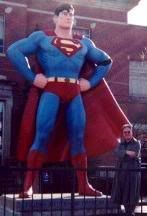| Pop Culture Gadabout | ||
|
Friday, April 12, 2013 ( 4/12/2013 05:50:00 PM ) Bill S.  It’s DC’s success with the JLA (a revamped version of an earlier company team, the Justice Society of America) that sparked comics publisher Martin Goodman into charging writer Stan Lee with the task of creating a new super-team that would become the Fantastic Four. With the FF’s debut in 1961, the Marvel Age of Comics was beginning, though it took many comics fans time to actively notice: understandable since, as Wells points out, the cover to the premiere issue looked indistinguishable from the rampaging monster comics that Lee and collaborator/artist Jack Kirby had been cranking out to a modestly loyal readership since 1959. Lee and Kirby’s biggest storytelling innovation at the time was to do something that DC – who had built its team with already established characters – didn’t dare do: make its team fallible and frequently bickering. In so doing, they established the Heroes with Problems template that would arguably find its greatest symbol in the Amazing Spider-Man. The only way that DC could force its super folks to break their mold at the time was through alternate world “Imaginary Stories,” a ploy that many slightly older comics fans pooh-poohed. Marvel’s flawed figures had an air of “realism” to them that the canny Lee hyped to the company’s benefit. Chronicles doesn’t limit itself to the Big Two’s super-hero titles, though. Wells’ overview examines all the other comics publishers of the day: Dell and its successor Gold Key, Archie, ACG, Harvey, Charlton – along with the cape free titles produced by DC and Marvel: romance, western, war comics. If a few lines don’t receive as full a focus as others, it’s generally because their titles were largely inflexible: a 1959 Caspar, the Friendly Ghost wasn’t much different from one in 1964, after all. Wells does capture the story innovations that some long-standing characters experienced: the establishment of a non-imaginary DC multiverse in Gardner Fox and the recently deceased Carmine Infantino’s “Flash of Two Worlds,” for instance, which gave DC’s writers the opportunity to place modern versions of their super characters alongside their Golden Age incarnations. Wells notes those current events that were reflected in comics of the day: appearances by John F. Kennedy and the Beatles in sundry titles (including the quirky superhero satire, Herbie, the Fat Fury), Cold War references that were particularly prevalent in Marvel’s early series like Iron Man.. He even considers the somewhat anachronistic sixties era pleas for racial tolerance that appeared in both DC and Marvel’s war comics: mild fare today but commercially risky at the time. Chronicles also considers comic magazines spin-offs like Mad (originally a four-color EC comic book) and Creepy, the first and most successful attempt to transplant pre-code horror comics storytelling into a black-and-white format. To a comics reader too young to have caught the original Tales from the Crypt and its ilk, Creepy and its spin-off title Eerie were as profound an influence as the original demonized ECs. In 1960, Wells notes, Mad was the highest selling comics title in the U.S., just ahead of Dell’s best-selling titles Uncle Scrooge and Walt Disney’s Comics and Stories with a yearly average of over a million copies sold per issue. Both Dell and Mad managed to bypass the strictures of the Comics Code Authority set up to appease parents worried by the Eisenhower Era comics scare: Dell because its affiliation with family-friendly companies like Disney carried its own tacit seal of approval (“Dell Comics Are Good Comics.”), Mad because its status as a black-and-white magazine set it outside the bounds of code authority. Along with the comics themselves, the early sixties proved a fertile period for the comics fandom that was starting to come into its own. Befitting TwoMorrow’s status as a fannish publishing company, Chronicles also documents the first appearance of the first big name fans and their zines – which would have an impact on the industry in the years ahead. Some might argue whether the “fanboy” voice, which certainly was heard by attentive editors at DC and Marvel, helped or stunted the industry over time, but the fact remains that names like Alter Ego’s Roy Thomas would themselves find a place as comics creators in the years to come. “It is our intention,” Marvel voice Stan Lee wrote at the end of the period covered in this volume, “here at Marvel, to produce comics which are so well-written and well-drawn, that they’ll elevate the entire field in the minds of the public!” Within that characteristic bit of bombast was a sentiment that spoke for the industry. After a period of the creative and economic doldrums, the comics industry was starting to revive – Wells' Chronicles does an admirable job capturing that era.
(First published on Blogcritics.) Labels: comics history # | |
|
|

